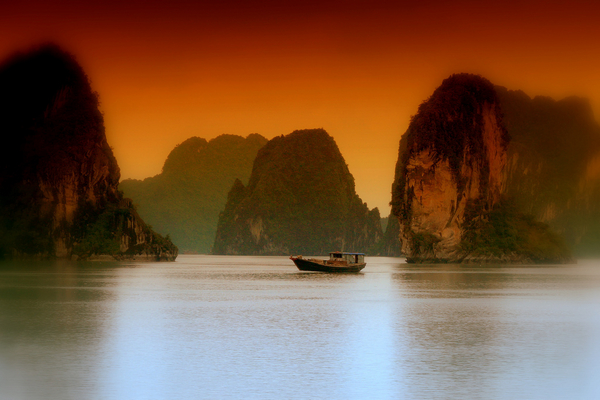The Dead Sea, the Great Barrier Reef, Grand Canyon, Uluru, Iguazau Falls and 23 other miracles of natural creation – go try and pick just seven! Is there any point in discussing the superiority of one over another? Nevertheless, the list of New 7 Wonders of Nature has been announced, whether we think it's unfair or not. The choices are still provisional as the voting calculation is now being validated and the confirmed winners will be announced not earlier than during the Official Inauguration ceremonies early in 2012. Here's what we are expecting to find among “the Great Seven”.
The Amazon
Encompassing seven million square kilometers and spreading over nine countries, the Amazon Basin comprises the most astounding and most species-rich tract of tropical rainforest on Earth. Over 500 mammals, 175 lizards, over 300 other reptile species, one third of the world's birds and about 30 million insect types compete for survival in the thickets of the canopy jungle. The life force of the rainforest - The Amazon River - is the largest river in the world by volume and for much of its path, it can be as wide as 11 kilometers. With a total flow greater than the top ten rivers worldwide combined, the Amazon gushes around 105 billion liters of water into the Atlantic every minute. Not a single bridge crosses the Amazon.
Halong Bay
Countless tourists flock to Vietnam with the sole purpose of witnessing the wonder of Halong Bay. Some 1,900 islands and islets - mostly uninhabited and unaffected by human presence – make up for approximately 1,553 square kilometers of a stunning seascape. Enormous caves and numerous lakes found inside some of the islands are yet another factor that makes Halong Bay an unmissable corner of the world. Here and there, floating villages of fishermen are supported by enormous karst formations – a picture that dwells in the heart forever after.
Iguazu Falls
No words can describe the collective splendor of 275 falls making up Iguazu. Found on the border between the Brazilian state of Paraná and the Argentine province of Misiones Falls, the semi-circular wall of gushing water extends over 2,700 meters and is surrounded by two national parks that brim with rare species of wildlife. Two paths are available for tourist. Take the lower one leading to the base of the falls to get sprayed all over or choose the upper circuit for an astounding panoramic view of Iguazu's majesty – both options will leave you completely at a loss for words.
Jeju Island
Situated just off the southern tip of South Korea, Jeju Island is a perfect getaway for those keen on hiking, catching sunsets over the ocean, riding horses or just winding up on sandy beaches. Although tourism is taking a firmer and firmer grip of the island, it manages to retain its paradisaical quality and many of the facilities are kept low-key. A central feature of Jeju is Hallasan, the tallest mountain in South Korea and a dormant volcano, which rises 1,950 m above sea level.
Komodo
Initially established to conserve the endemic Komodo dragon, Indonesia’s Komodo National Park now protects the entire biodiversity of the three larger islands Komodo, Rinca and Padar, as well as numerous smaller ones, all of volcanic origin. Craggy hillsides, lush vegetation, snow-white beaches and azure waters surging over coral make up for a serene, multicolored vacation setting. The presence of the giant, aggressive lizards, however, gives the park a certain air of harshness and thrill.
Puerto Princesa Underground River
The Puerto Princesa Subterranean River winds through a cave located about 50 km north of the city of Puerto Princesa, Palawan, Philippines. A clear, inviting lagoon framed by ancient trees has formed at its mouth, but is not in the least bit foretelling of what you are going to see as you enter the abyss in a tiny rowing boat. Serene and sparking on the outside, the 8.2 kilometer navigable river takes you into a dark, sinister realm of overwhelming silence and giant karst formations. Molded over hundreds of years, the impressive stalagmites and stalactites often resemble real life objects and creatures. Until the 2007 discovery of an undeground river in the Yucatan Peninsula, the Puerto Princesa river was reputed to be the world's longest subterranean waterway.
Table Mountain
Table Mountain is a South African icon and the most recognized landmark of Cape Town. The flat-topped formation with peaks reaching 1,086 m above sea level has withstood six million years of erosion and is the only natural site on the planet to give name to a constellation of stars - Mensa, which is Latin for "the table." A distinguishing feature of its unique ecosystem is the richest, yet smallest floral kingdom in the world, including over 250 different species of daisies! The mountain is discernible from almost everywhere in the city and yields some absolutely dazzling views of Cape Town's fabulous beaches. A cable car ride to the top is an unmissable experience that forever throbs deep in the heart.
Here's the full list of 28 finalists. Would you rather see something else among the Great Seven?
- Amazon Rainforest and River
- Angel Falls
- Bay of Fundy
- Black Forest (Germany)
- Bu Tinah Shoals
- Cliffs of Moher
- Dead Sea
- El Yunque
- Galapagos Islands
- Grand Canyon
- Great Barrier Reef
- Halong Bay
- Iguaçu Falls
- Jeita Grotto
- Jeju Island
- Kilimanjaro
- Komodo Island
- Maldives
- Masurian Lake District
- Matterhorn / Cervino
- Milford Sound
- Mud Volcanoes (Azerbaijan)
- Puerto Princesa Underground River
- Sundarbans
- Table Mountain
- Uluru
- Vesuvius
- Yushan














No comments:
Post a Comment